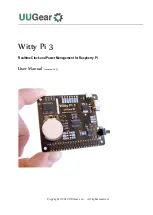
Refrigerating Specialties Division
5
Disassembly and Assembly (continued)
All A4A Regulators General Procedure
The construction of the regulator and the method of disassembly are
relatively simple, but some procedures must be followed to avoid
damage. The following describes the procedure for the basic A4A;
special instructions for other types are included in other appropriate
sections.
Disassembly -
Take care when removing Seal Caps 1 and 44 in case
some refrigerant may be trapped inside. Back the Adjusting Stem 6
all the way out to remove any pressure from Range Spring 13 otherwise
damage to Diaphragm 17 or Pilot Seat 18 may occur. Remove Bonnet
8 by carefully removing Cap Screws 11. Take care not to damage
Diaphragm Follower 15. Remove Adapter 28 by removing Cap Screws
31. Turn the Manual Opening Stem 33A all the way in until the flats on
the stem barely protrude from the stuffing box nut. Push Piston 30
down against the spring force. The piston should move freely down
and be returned by the spring force. If the piston is jammed or sticky,
remove Bottom Cap Assembly which includes Items 33 through 42 by
removing Cap Screws 39 or unscrewing Bottom Cap, 20mm through
32mm (3/4” through 1-1/4"). Using a hard wood dowel rod inserted
through the bottom of the valve, tap the piston upward and out.
Thoroughly clean all parts. If jamming has taken place and the piston
and bore are scored, remove all burrs by polishing the piston, bore
and throttling plug with fine crocus cloth. Inspect the seating area of
the Throttling Plug 33 for damage or erosion. If damaged it should be
replaced. It would be advisable to replace the entire bottom cap
assembly. Inspect all gaskets and “O” rings for damage and replace
where necessary.
Assembly -
When reassembling the valve, all internal parts should
be clean, dry and lightly oiled with refrigerant oil, except “O” rings.
Apply silicone grease to the “O” rings. Care must be taken especially
when the parts are cold since moisture can condense on parts and
cause rapid rusting. When replacing gaskets, they should be oiled
very lightly with refrigerant oil before assembly. Install bottom cap
assembly first and tighten in place. Carefully replace the piston; never
try to force it in place. Align the Adapter Gasket 29 carefully with the
proper holes in the adapter and valve body and fasten adapter in
place. Before assembling the bonnet be sure the Adjusting Stem 6 is
turned all the way out and that the Bonnet 8 and Diaphragm Follower
15 are properly aligned, otherwise damage to the diaphragm and pilot
seat may occur. Place Gasket 19 in the adapter and align Gasket 16
and Diaphragm 17 to the center of the bonnet. The raised center of
the diaphragm must be towards the bonnet. For range “D” use two
diaphragms. Tighten Cap Screws 11 evenly. The ideal tightening torque
is 1.5 Kg-m (11 ft. lbs.). Valve is now ready to be adjusted for normal
operation.
If close coupled strainer is used, it may be cleaned before putting the
valve back in operation. The regulator must be tested for leaks with
refrigerant gas or other appropriate gas before the system is put into
operation.
Fig. 8 (A4AZ)
Fig. 9
S6A
MODULAR SOLENOID PILOT
A2D
MODULAR PRESSURE PILOT
MODUPLATE


































